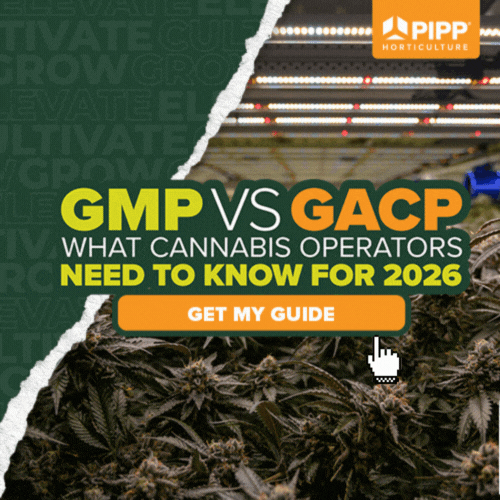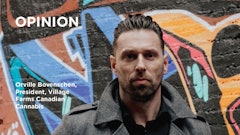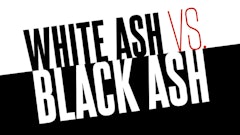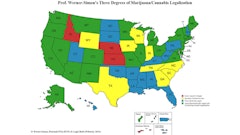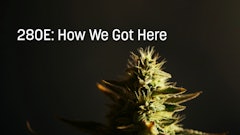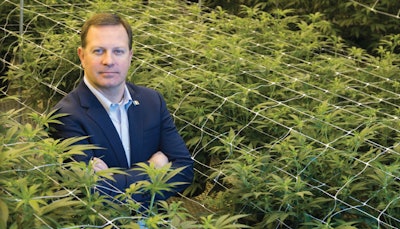
As General Counsel and Chief Compliance Officer of PharmaCann, LLC, Jeremy Unruh is uniquely positioned to talk about regulatory issues facing commercial cannabis. PharmaCann operates six Illinois facilities—two state-of-the-art cultivation centers and four dispensaries—as well as a manufacturing facility and four dispensaries in New York. The company also is pursuing licensing or developing projects in Maryland, Massachusetts and Pennsylvania.
Talking with Unruh about the industry’s regulatory challenges, as well as major differences between East Coast and West Coast regulations, are special Guest Interviewers Andy Bozzuto, majority owner, and Tom Schultz, president, of Connecticut Pharmaceutical Solutions (CPS), one of four licensed producers in Connecticut’s strictly regulated medical marijuana market.
Andrew Bozzuto: Jeremy, obviously your hands are full with the regulatory component of all of those locations. With different guidelines and regulations for every state, which state do you think is most compliant? I understand New York is a very difficult one to deal in.
Jeremy Unruh: From my perspective, there is a very East Coast or eastern-style of cannabis regulation, and there's a very western style of cannabis regulation. As you know, the first medical marijuana laws in the county arose in the early '90s in Oakland in response to the AIDS/HIV epidemic. From a compliance perspective, what western operations tend to look like now is the product of an evolution from those early laws.
Conceptually, those early ordinances said things like, "If you have some plants in your basement or your garage, you can have a few more and give the product to friends and family." Then from there it was, "You can sell it, but it has to be under a not-for-profit scheme." What we see in those western states now has evolved from legitimization of early black- and gray-market activity.
In the East—states like Connecticut, New York and Illinois—the regulators literally invented an industry from scratch and drafted regulations to build that industry. That's why in the East, our facilities look and operate so much differently than what one might expect to see in Colorado and California.
In Connecticut, New York and Illinois, you don't see a patient care representative in a dispensary forking cannabis out of a Mason jar onto a scale. You see products that are prepackaged at the cultivation centers. Tamper-evident, child-resistant packaging with labeling and third-party testing, all those consumer protections that we in the East take for granted. For instance, a product recall plan is something you or I take for granted. Well, they've never heard of a product recall plan in many places in California. That's not reflective of all operators in the West, but there is certainly a difference in mindset, style and perspective.
I think ... in the states I’m aware of, New York probably has the most rigid, true medical regulatory scheme. Pennsylvania will probably supplant New York because Pennsylvania has this interesting component of its statute, called "Chapter 20," that allows for a class of super-licensee where one develops a formal relationship with an academic clinical research center to connect the dots among the healthcare community, academia and cannabis producers; cultivation, formulators and dispensers.
I also think it depends on what area of regulation you're talking about. In Illinois, our cultivations centers are governed by the Department of Agriculture. The Illinois Department of Agriculture is really good at ethanol and the corn industry. As a result, the regulations dealing with, say, pesticides are very well developed because those folks in the Department of Agriculture have a granular understanding of pesticide usage and labeling, and other similar requirements that are consistent with that agency’s sphere of responsibility outside of the cannabis sector.
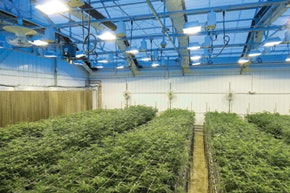
In New York, the program is administered by the Department of Health's Bureau of Narcotic Enforcement. That's the unit of the Department of Health that investigates and enforces matters involving controlled substances at nursing homes, pharmacies and hospitals. They don't know as much about pesticides, but they know a lot about proper dispensing practice, dosing and handling controlled substances. ...
Colorado is in its second or third iteration of edible regulations, so that's a very highly developed regulatory scheme they have, so, again, I think it depends on what components of the regulations you're talking about.
Thomas Schultz: You properly characterized Connecticut as on the eastern side of regulatory structures. … There's a lot of pharmaceutical background. These regs came from our pharmaceutical regulatory body, but our regulators leaned heavily on federal structures that already existed.
When it comes to pesticide regulation, the Connecticut regulators immediately had a dialogue with an FDA lab that was familiar with residual pesticide testing as required under the U.S. Department of Agriculture. So it moved very quickly to identify what would be appropriate and inappropriate. Connecticut got to that place reasonably efficiently.
Unruh: That's incredibly important in the cannabis space. Groups like ours are focused on making cannabis a part of mainstream healthcare, at least an alternative that can be explored by physicians for the treatment of their patients. At some point there's going to be a shift in the federal perspective on cannabis. It could be rescheduled or simply tolerated under a handful of bills that are being proposed right now, but I think you're going to see the market bifurcate.
I think there will be two types of providers. One provider will be positioned to operate within the existing FDA scheme for the development of pharmaceuticals or other products. Other providers will continue to operate outside of federal blessing, as the industry does right now. I wonder if that isn't going to be along the lines of dried flower, on one hand, versus extracted, infused products on the other.
Schultz: In terms of talking about federal and state interaction, do you see any key sources of standards that might apply to either side of the industry, either predominately recreational or predominately medical?
Unruh: Ultimately I think we're going to have to end up in the existing FDA process—you know, Investigational New Drug Applications and clinical investigators and preclinical research, and so forth. We’re going to have to fit into that scheme. But I am aware that the ASTM, the American Society for Testing Materials International, recently indicated they were convening a working group to establish standards in the cannabis space.
That's a tremendous opportunity for folks in the space who have some degree of knowledge and influence to get together and produce self-governing standards. It's like the movie industry; it's always better to regulate yourself than have the government come in and do it for you. I think it's critical. This sort of thing is a really good step forward, so I'm looking at that as a potential source of standards.
Schultz: Self-regulatory structures obviously exist in the United States in many industries, and most lawyers become aware of the self-regulatory sort of bodies that affect their particular clients. But can you speak from any experience about bringing self-regulation to an industry or what self-regulation’s goals or accomplishments might be?
Unruh: I don't know that I can speak to it personally other than having seen it done. I know that the edibles manufacturers in Colorado worked hard to lobby the state regulatory board to ensure new edible regulations were workable. The first regulatory proposal for a universal symbol on edibles packages was a skull and crossbones. That denotes poison, and poison isn't what you and I and those folks in Colorado are producing for patients.
The industry had to come up ... with a symbol that may not have been what it wanted ..., but it was palatable enough to pass regulatory muster. To me, that's a tremendous example of how important it is to have some sort of self-regulatory function in our industry, whether that's state by state or a third-party like ASTM International ... convening experts, and coming up with standards.
We ... exist in an industry that is not without controversy. I mean, it's a sexy industry. People care about [it], but people don't always care in the same way we care. It's important that we figure out ways, collectively, of advancing our agenda, but doing so in a way that the most conservative senator in the state can sign on and tolerate.
I'm a former prosecutor, and I trot that out and talk about my experiences as a prosecutor and how we build a culture of compliance in our organization. I think it's important for us to do that collectively and voluntarily, otherwise the alternative is that compliance will be imposed by the state.
Schultz: Do you see these guidelines ... as something that might influence behavior across state lines? Let's say ASTM matures and puts out a set of standards. Do you see that as something that might influence both western states and eastern states?
Unruh: I hope so. I think it's most important for external standards to influence things at the federal level and to create an environment—self-regulatory or regulatory—that will have the result of loosening up or modifying the federal restrictions on our industry. I think a self-governing mindset is in support of that.
Schultz: If we switch from the pharmaceutical side to the commercial side, what would you see as the greatest challenges to the commercial side right now?
Unruh: I think the greatest challenge to the commercial side is the current uncertainty in the political climate. The comments we've seen from Attorney General Sessions and the President's Press Secretary were intended to imply a change in the status quo. Those fairly innocuous comments create tremendous uncertainty.
From a commercial perspective, there is a commoditization of the product that you're seeing. That's why prices are beginning to drop in states like Colorado and Washington. I'm not an economics guy, but as a general proposition, I think that's a challenge. The task at hand now is to figure out branding and positioning in the industry and not be all things to everybody. Figure out where your product is, who your product speaks to, and then push forward on the product.
In Illinois we have a delinked vertical, meaning that cultivators and dispensaries can freely buy from and sell to one another. As a result, you have roughly 20 cultivation centers and 40 dispensaries, all of which are entirely separate from a regulatory perspective. But the state has created regulations that require cultivation centers to sell cannabis to dispensaries on equal terms, setting aside volume discounts and transportation costs, and that sort of thing. So you have this developing wholesale market in Illinois. This helps the market there alleviate some of the challenges you find in states where artificial monopoly rules are more restrictive.
In the East, we're seeing the development of brands and brand preference, like they’ve done in Colorado and in California for a really long time. Cresco Labs in Illinois is a great example. Cresco has focused on their wholesale products and their brand, and as a result, they produce consistent, very attractive commercial products. I think you're going to see a lot more of that brand focus.
Additionally, dried flower is something that can be bought and sold in Illinois. So there's a little bit of a hybrid feel for Illinois, which I consider to be one of the earlier sort of eastern-style states.
Bozzuto: We talk about edibles, and in Connecticut it’s allowed in [the form of] baked goods only. Even in the regs, they wanted us to lean away from edibles. What they did want to see was the development of delivery systems applicable to today's medicine. So we've crystallized our oils, and now we're in tablet form. We have time-released tablets and all kinds of different approaches from inhaling all the way through your tinctures.
On that front, do you see edibles still being prevalent a few years from now? We're already into tablets on the East Coast; do you see that encroaching over into that edibles market?
Unruh: That's a good question, and I don't really know the answer. I do think that some of it is cultural. When people walk into dispensaries, they have expectations, and it's going to be awhile–I don't know if [it'll be] three years or five years or a whole generation–before those preferences and expectations morph and modify. …
I do, however, think that edibles are going to be around, regardless. I don't, however, necessarily know that everything is going to be sweet. There is a savory market out there in the edible space that is largely untapped and unexplored. It's starting to turn. You're seeing infused coffee and tea, and K[eurig]-cup stuff and marinara, and that kind of thing.
But edibles are a much different creature than tablets and even capsules, and what I would call true pharmacy-delivery methods, such as suppositories, that kind of thing. Those true-pharma delivery methods are intended to open up the cannabis space to people who are seeking to augment true healthcare, and who may not be open to cannabis already. My mother-in-law with her arthritic hands is probably never going to eat a brownie, but she might rub a topical CBD product on her arthritic fingers.
Bozzuto: Right. Connecticut was adamant to drive that end of it first. The regulations here drive us to formulate the medicine side first. I guess one of the early analogies we used to use is that the pharma can always grow rec, but rec can't always grow pharma.
When we started in Connecticut, they said, "We suggest you take the high-end approach." I'm very glad we did, and I think it's really a niche market for all of us. I think the more we can get this together in our network from East to West Coast, it definitely elevates the standard of play in our industry. This horse has been out of the barn for 30 years, we're just trying to get controls around it that make it acceptable to the rest of society.

